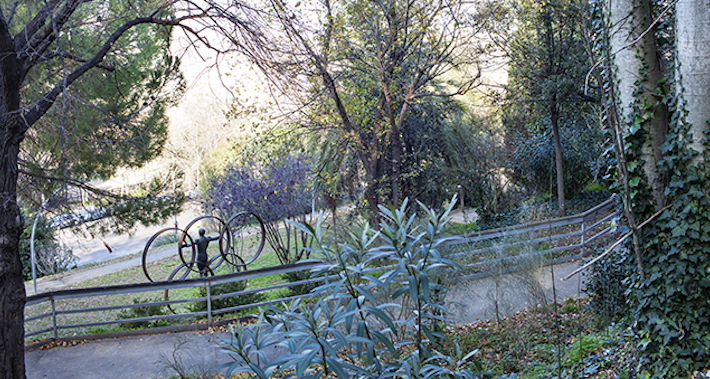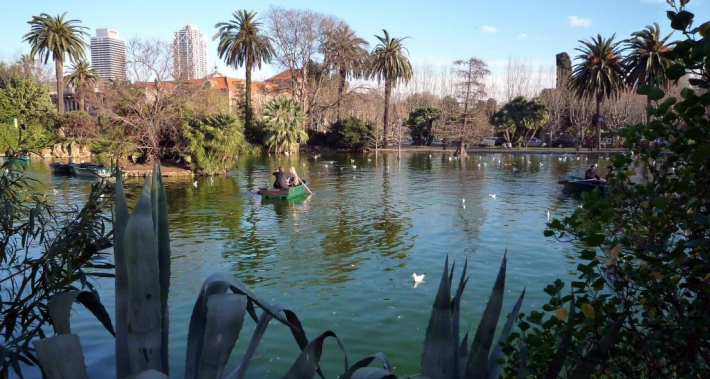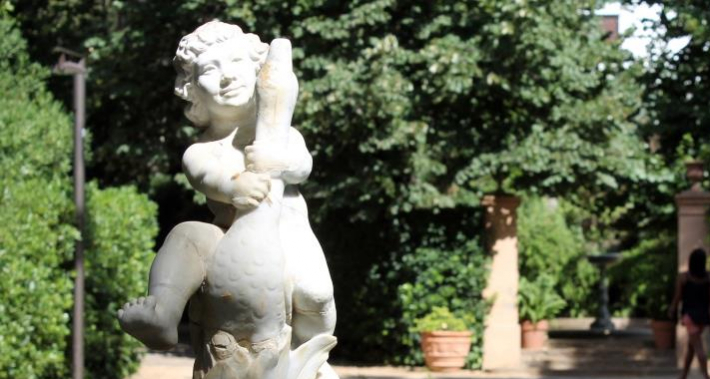The 1929 Exhibition
This other famous exhibition, the 1929 International Exhibition, was the event which instigated the creation of gardens in an area of Barcelona which was very popular among the city's inhabitants: the Montjuïc mountain, where the abundance of vegetation and natural fountains had given rise to many popular allotments and the use of the mountain as an area for leisure and country walks.
At the request of the architects Josep Amargós and Josep Puig i Cadafalch, the organizers of the Exhibition commissioned the French landscape engineer Jean-Claude-Nicolas Forestier, park keeper of the Paris parks, to create gardens on a part of the mountain. In order to carry out this project, the French engineer was helped by Nicolau Maria Rubió i Tudurí, a tandem which left behind an important legacy within the green areas of Barcelona. Thus, as well as the creation of the Montjuïc Gardens: the Laribal Gardens, Font del Gat (today integrated into the Laribal Gardens), the Amargós Gardens -today the Teatre Grec Gardens - and others, we should add the Plaça d'Armes Park (1915) the Parc de la Ciutadella and the historical part of Guinardó Park (1918). In 1923 Parc Güell, designed by Antoni Gaudí, was inaugurated,.
Rubió i Tudurí
An eminent specialist in landscaping during this period, Nicolau M. Rubió i Tudurí was a key figure in the landscaping of Barcelona, both for his work on such important green areas as Font del Racó Park (1922-28), the Palau de Pedralbes Park (1925-27), Plaça Francesc Macià (1926) and Turó Park (1934), as well as for the creation of a network of green areas in the city. Since its creation in 1917, and until his exile to France in 1937, Rubió i Tudurí was the director of the Barcelona Public Parks Department, from where he made a great effort to procure as much land as possible to be destined to the creation of municipal parks and landscape reserves.
In order to give coherence to the policy of municipal acquisition of land, Rubió created a rational structure of distribution of free areas which he set down in a paper titled "The problem of open areas", presented in 1926 at the eleventh National Congress of Architects. In this document, Rubió i Tudurí records the general idea which had been presented in the Linking Network Plan by Léon Jaussely in 1905, on the need to create a complete system of green areas divided into different levels according to their use and characteristics (forests, parks and children's gardens, etc). The result was a semicircle enclosed by the landscape reserve of Collserola, to which the rings of the external parks were concentrically followed by suburban parks, city parks and finally, at the heart of the city, the district gardens.
From 1940 to 1970
The Civil War was a period of transition in the creation of new green areas in Barcelona. Once the war was over and until the arrival of democratic city councils, the development of public areas in the city concentrated on the organizing of the already existing green areas, which were installed with the infrastructures and facilities necessary for their use as parks. The Turó de Monterols Park (1947) was built during the first decade of this period. New gardens were also created in Montjuïc, in the area immediately above that designated by Forestier for the Exhibition of 1929.
At the end of the nineteen sixties and the beginning of the nineteen seventies, interest in collections of plant species prompted the creation, in two disused quarries situated on the mountain of Montjuïc, of the Mossèn Costa i Llobera Gardens (inaugurated in 1970 and dedicated to succulent and exotic cactus plants) and Mossèn Cinto Verdaguer Gardens (also inaugurated in 1970 and dedicated to bulbs and rhizomic plants). The Cervantes Park (1965) and Joan Maragall Gardens (1970) were also inaugurated around this time.
During these two decades, the Barcelona City Council continued with the policy begun by the Barcelona Department of Public Parks of purchasing private estates at the beginning of the century, with the aim of increasing the number of green areas. This permitted the incorporation into the city's green heritage of La Quinta Amèlia Gardens (1970), the Castell de l'Oreneta Park (1978), the Parc de les Aigües (1978) and the Horta Maze Park, on land acquired in 1967 and opened to the public in the spring of 1971.
From 1980 to 1990
With the arrival of democracy, a policy designed to create more green areas was set up. Many areas occupied by obsolete installations were converted into parks, as in the case of Joan Miró Park, built in 1983 on land previously occupied by the old central slaughterhouse of Barcelona.
Other green areas were made possible thanks to the repossession of private estates, such as the Vil·la Cecília Gardens (1986) and the Ca n'Altimira Gardens (1991); the procuring for the city of areas belonging to old factories, such as the L'Espanya Industrial Park (1985), the Pegaso Park (1986) and the Clot Park (1986), and the transformation into parks of land occupied by old railway installations, such as Sant Martí Park (1985) and Estació del Nord Park (1988).
The transformation of the majority of these areas was also made possible thanks support from local inhabitants.
Barcelona 92
The urban development which took place in Barcelona at the time of the 1992 Olympic Games permitted, just as in the case of the Universal Exhibitions of 1888 and 1929, the development of those parts of the city which were more in need of development and green areas.
This is the case of the Olympic Ring and the Olympic Village in Poblenou and Vall d'Hebron. Large green areas were created here, such as Migdia Park, Poblenou Park, Carles I Park and Vall d'Hebron Park, all inaugurated in 1992 and which offer facilities for sports and the opportunity to commune with nature without leaving Barcelona.
The Can Dragó Sports Park (1993), the Nou Barris Central Park (1999) and the Diagonal Mar Park (2002) are three further examples of the creation of new public green areas initiated at the beginning of the nineteen nineties.
With the creation and remodelling of public areas within this large city development plan, the renovation of the city's sea front also stands out. Although it is not a green area, it has become one of the main leisure areas of Barcelona. Thus, the area that at the beginning of the 20th century was considered an impassable line, has with time become an open door to the Mediterranean.
The Fòrum 2004
The Fòrum 2004 represented the final consolidation of the opening of Barcelona to the sea, initiated in 1992. The development of the Besòs Coastline, situated to the south of the mouth of the river, was carried out on a surface area of 214 hectares, five times larger than the Olympic Village.
The creation of more green areas is based on a concept of unity and continuity within the city areas and the parks. The result is a collage which integrates with the rest of the city.
The remodelling of the area housing the Fòrum de les Cultures 2004 included the construction of three new large green areas: the García Faria Lineal Park, the Auditoris Park and the North-East Coastline Park, situated on the limit between Barcelona and the neighbouring district of Sant Adrià de Besòs.




